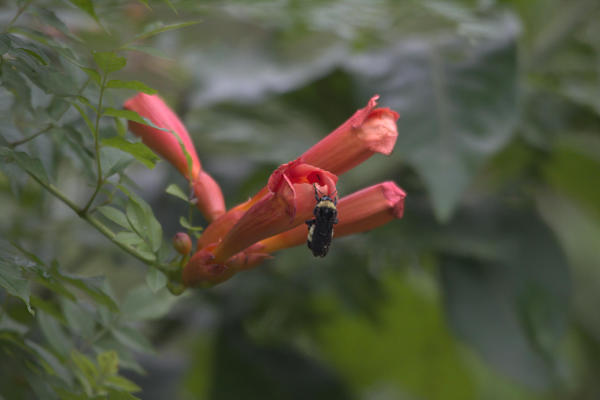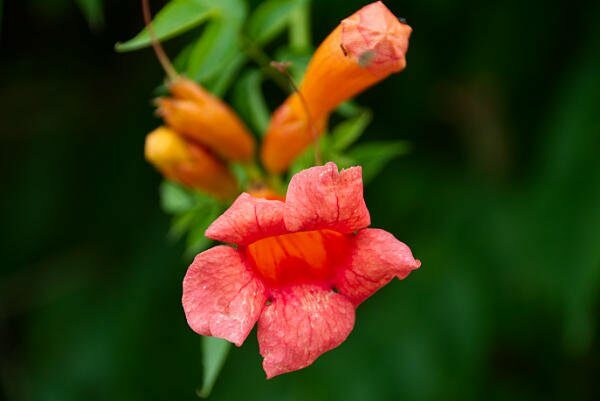Are you ready for a plant that can trumpet its beauty all over your garden? Look no further than the trumpet vine! This striking plant is a favorite among gardeners for its vibrant orange blooms and ability to attract hummingbirds. But with great beauty comes great responsibility – the trumpet vine can be an aggressive grower and may require some taming. In this article, we’ll explore everything you need to know about the trumpet vine, including its care, uses, and potential drawbacks. So let’s dive in!Shortcode
The trumpet vine is an easy-to-grow vine that can be considered invasive. It blooms with showy orange, yellow, and even red blooms. Bees and hummingbirds love the nectar the flowers produce. But beware; once you get it going, it may take over the yard if not properly trimmed back. The species we normally see in the central and eastern US is the American Trumpet Vine (Campsis radicans). There is also a variety native to China. In the US, it is also called hummingbird vine or cow itch vine. Read on to find out all about the trumpet vine.
Habitat of The Trumpet Vine
The trumpet vine, also known as Campsis radicans, is a native plant to the southeastern region of the United States. It can also be found in some parts of Mexico and Central America. As a fast-growing deciduous vine, it is known for its showy orange trumpet-shaped flowers that bloom from midsummer to early fall.
In its natural habitat, the trumpet vine is commonly found climbing up trees, fences, and rocky outcroppings. It prefers well-drained soils with moderate moisture and plenty of sunlight. However, it can adapt to a wide range of soil types and growing conditions. It is commonly found in disturbed areas such as roadsides and clearings, as well as in natural areas like woodlands and prairies.
While the trumpet vine can grow in a variety of habitats, it is important to note that it can become invasive in some regions. Its vigorous growth and ability to spread quickly through root suckers and seed dispersal make it a challenge to manage in some landscapes. As such, it is important to consider the potential impact of planting a trumpet vine in your garden, especially if you live in an area where it is not native.
They are listed as an invasive weed by the US Department of Agriculture because they can be almost impossible to get rid of once established. And they are surprisingly hardy, enduring harsh winters to come back the following spring. They produce tons of long, trumpet-shaped flowers all summer long.

Perfect To Attract Pollinators
Butterflies, hummingbirds, and many species of bees are attracted by the showy flowers. Hummingbirds are especially fond of these flowers because the long, trumpet-shaped flowers are perfect for the long beaks of the hummingbird. I have seen honeybees, bumblebees, and several species of small metallic bees buzzing around the flowers during the blooming season. If you need to attract pollinators for your garden, these plants are perfect for that purpose.
Be Sure And Prune Trumpet Vine Aggressively
This plant is known for its aggressive growth and is considered invasive in some regions. It is an excellent choice for covering unsightly fences, walls, or trellises and providing shade and privacy.
The trumpet vine is a deciduous plant and produces stunning clusters of trumpet-shaped flowers that bloom from mid-summer through early fall. These flowers can be orange, red, or yellow and attract hummingbirds, butterflies, and bees. The plant also produces bean-like pods that contain seeds, which can be collected for propagation.
The trumpet vine grows well in full sun or partial shade and prefers moist, well-drained soil. It is drought-tolerant and can withstand extreme temperatures, making it an ideal choice for gardeners in many regions. This plant is hardy in USDA zones 4 to 9, and it can grow in many soil types, including sandy, loamy, or clay soils.
It is important to note that the trumpet vine can be difficult to manage due to its aggressive growth habits. It can spread rapidly and overwhelm nearby plants if not properly pruned and maintained. Therefore, gardeners should take care to plant it in an area where it has plenty of room to grow without interfering with other plants or structures.

Trumpet Vines Are Extremely Hardy
They are resistant to most diseases and pests. This makes them extremely easy to grow, but hard to get rid of. Each flower will produce a seed pod about 6 inches long. These pods are filled with paperlike seeds, which disperse in the wind around the plant when they pop open. These seeds will produce new plants, which can be very hard to get rid of. If you want to prevent them from taking over, the best way is to pull the flowers off as they die and begin to set the seed pods. Pull any young seedlings at the first sign of them.
Toxicity of Trumpet Vine
While it is a favorite among gardeners and landscaping enthusiasts, it is important to note that this plant is toxic and can cause harm to humans and animals if ingested.
All parts of the trumpet vine contain a toxic resin called urushiol, which can cause skin irritation, blisters, and rashes. This resin is also present in poison ivy and poison oak, so if you are allergic to those plants, you should avoid the trumpet vine as well.
Ingesting any part of the trumpet vine can cause a variety of symptoms, including vomiting, diarrhea, nausea, and stomach pain. In rare cases, it can cause more serious symptoms such as difficulty breathing, seizures, and even death.
It is important to handle trumpet vines with care and to avoid ingesting any part of the plant. Keep children and pets away from the plant and wear protective clothing such as gloves and long sleeves when handling it. If you suspect that someone has ingested any part of the trumpet vine, seek medical attention immediately.
These plants are native to the Ozarks and can be found in the wild all over the Ozarks, especially along fences and roadsides. For more information on them, you can see this article on Wikipedia. You might also like to read about some of the other native Ozarks wildflowers, such as goldenrod, wild bergamot, and plantain.
Be sure and check out our list of articles to discover a wealth of information on other wild edible and medicinal plants.
FAQs:
Q: Are trumpet vines poisonous to dogs?
A: Yes, it can be toxic to dogs and cats if ingested.
Q: Can you touch a trumpet vine?
A: Yes, you can touch it without any harm, but be careful not to touch the sap, which can cause skin irritation in some people.
Q: Is trumpet vine related to poison ivy?
A: No, it is not related to poison ivy. However, both plants can cause skin irritation in some people.
Q: Why is Trumpet Vine bad?
A: It can be considered bad because of its invasive nature, which can cause it to take over and harm native plant species. Additionally, it can be difficult to control and remove once established.
Q: Is trumpet vine invasive?
A: Yes, it is considered an invasive plant species in some areas due to its rapid growth and ability to take over native plant habitats.
Q: What is trumpet vine good for?
A: It is primarily grown for its ornamental value, as its bright orange-red trumpet-shaped flowers are attractive to hummingbirds and other pollinators.
Q: Is trumpet vine a good plant?
A: It can be a good plant for those who are looking to attract hummingbirds and other pollinators to their garden. However, it should be planted with caution in areas where it may become invasive.
Q: Is the trumpet vine a pest?
A: It can be considered a pest in some areas due to its invasive nature and ability to spread rapidly. However, it can also be a beneficial plant for attracting pollinators to the garden.
